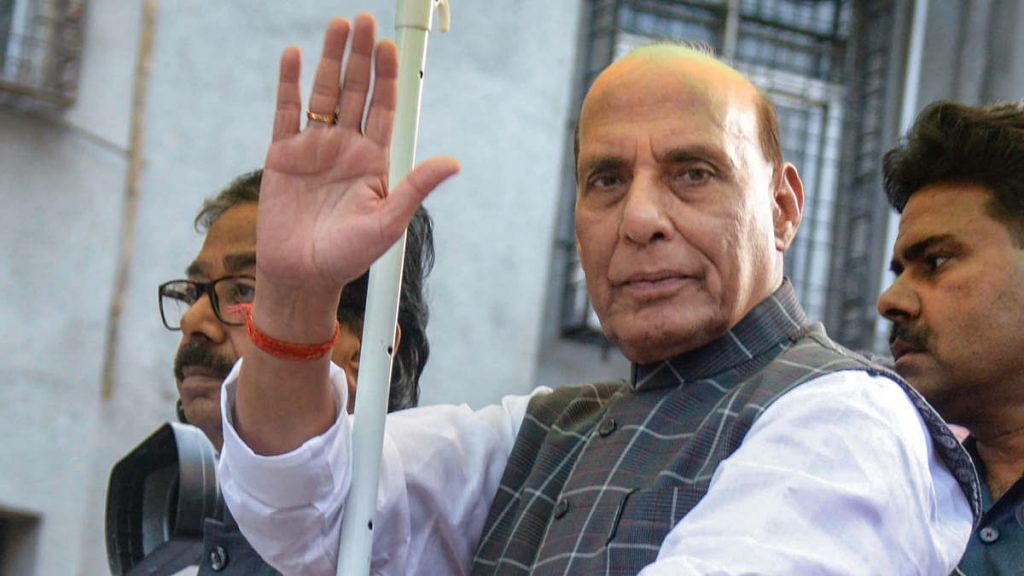The recently concluded monsoon session of Parliament was disastrous for the Narendra Modi government in terms of its ability to bring the opposition on board on crucial issues and the optics of building consensus.
The only exception, however, was the discussion around the tricky issue of India-China standoff in eastern Ladakh. And the credit for that goes to Defence Minister Rajnath Singh, who ensured that the government was not cornered by the opposition.
Through his handling of the China issue, Rajnath Singh has shown why the Modi-Amit Shah duo needs him. No other person, including Home Minister Amit Shah, would have been able to help the government tread over egg shells on such a delicate issue.
The multiple transgressions and incursions by China and the People’s Liberation Army (PLA) blocking access to areas Indian Army used to traditionally patrol are things that deeply embarrass Prime Minister Modi himself. This is because Modi has always projected himself as a sharp, strong Prime Minister with a teflon coating. He has always portrayed his closeness to Chinese President Xi Jinping – having met him 18 times since first coming to power in 2014.
However, Xi’s backstabbing has caught Modi by surprise. The reluctance to accept the intrusion in Ladakh at the all-party meeting on 19 June also led to a controversy and the Prime Minister’s Office (PMO) had to issue a clarification to beat the blowback from the defence and strategic community his statement caused.
Also read: How Depsang Plains is new catchword in India-China standoff & why Rajnath not talking about it
Only Rajnath Singh could have done it
Under such circumstances, the defence minister brought with him his ability to carry along the opposition when he spoke in the Lok Sabha and the Rajya Sabha.
Of course Rajnath Singh carefully skipped the part about the Chinese having intruded in Indian territory but he nevertheless managed to win the round by cajoling the opposition into not raising embarrassing questions and by reminding them of the operational sensitivity. He did all that while hitting hard at China and invoking the valour of the Indian armed forces.
No other minister, including Amit Shah, would have been able to pull this off. Shah’s “termite” remark against the Bangladeshis continues to haunt the country’s bilateral ties with Bangladesh, even though it may have been a strategic move to cater to his party’s core domestic constituency. In fact, many experts feel that Shah’s claims on taking back Aksai Chin was also a factor in China doing what it has done now.
Of course, the home minister was playing to the gallery of domestic macho politics but sensitive issues need to be handled carefully instead of being sacrificed at the altar of vote bank.
In normal circumstances, the opposition would have had their knives out in Parliament over the China issue but Rajnath Singh managed to nullify their attack.
Also read: No power in the world can stop Indians from patrolling along LAC, says Rajnath Singh
Carrying forward Jaitley’s legacy
Among Modi’s ministers since the Bharatiya Janata Party (BJP) came to power in 2014, the one politician who would have been able to pull off what Singh managed to was Arun Jaitley, known to be a consensus builder with a smooth communication line across parties.
With Jaitley no more, Rajnath’s skill becomes even more crucial for PM Modi whose government otherwise suffers from an embarrassingly poor bench strength.
Even in the armed forces, Rajnath Singh is looked upon with respect and admiration, something that held true in the case of his predecessor Manohar Parrikar.
Singh’s calmer and mature approach has given the military time to respond to China’s aggression in their own manner, which was quite evident on the intervening night of 29-30 August when the Army outflanked the Chinese-occupied key heights in the southern banks of Pangong Tso.
Another thing that Rajnath Singh has brought to the defence ministry is the political weight, which was missing during the tenure of Nirmala Sitharaman (the current finance minister). As I wrote earlier, Sitharaman was widely perceived as a lightweight minister who lacked administrative experience and political acumen. She was seen more as a stopgap arrangement until the 2019 Lok Sabha election, with most decisions being taken directly by the PMO.
Singh’s entry was a big change in terms of functioning within the ministry because his presence meant that outside interference is minimal.
As India Today reported in June last year: “Just hours after he was informed of his appointment as defence minister on May 31, Rajnath Singh dialled Army chief General Bipin Rawat. He wanted to spend his first working day, June 3, in Siachen. The army chief readily agreed. A little over 48 hours later, the defence minister was helicoptered into Siachen base camp, where he spent a day with troops at the world’s highest military deployment – 12,000 feet above sea level.”
“I started at the top,” Singh told his close aides after the visit, “and I will stay there.”
Views are personal.
